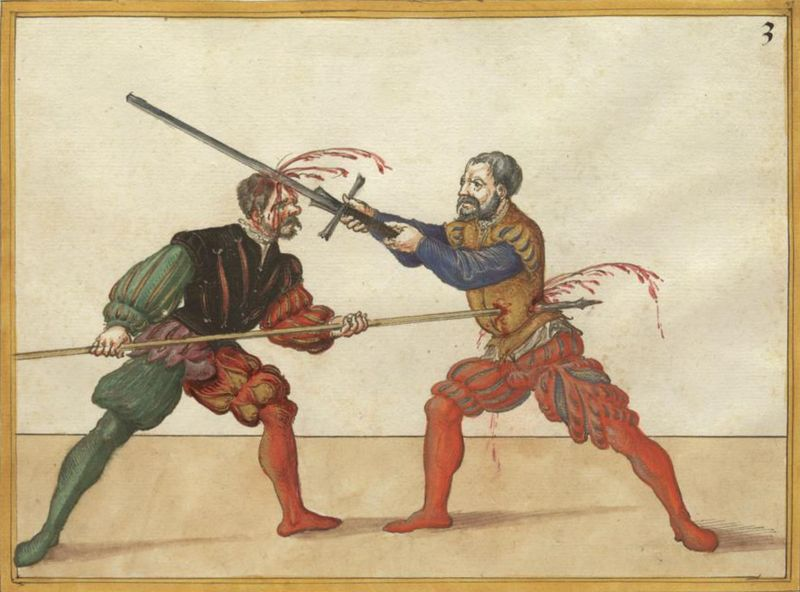
The more I think about tournament rules, the more it becomes apparent to me that a zero-sum solution to scoring will never get us the results we want.* But I’m going to guess that all “zero-sum” means to you is that I am using fancy terminology to make my ideas sound more impressive. So let’s get that out of the way first.
* As a martial arts training tool.
Zero-Sum
The term “Zero-Sum” and “Non Zero-Sum” refer to types of ‘exchanges’. Most typically it is used in the concept of economics (buying stuff), but it can be applied to anything, such as a tournament match.
Zero-Sum is a fairly simple concept to understand. Everytime you get something I have to lose the equivalent something. Consider a ‘something’ we can all relate to, wanting a bigger slice of the pie. Not in the symbolic sense. We are talking about a physical lemon meringue pie.

- We each have 50% of the pie.
- In order to get a extra piece of pie I have to deprive you of a piece of pie.
- In order for you to get more pie you have to deprive me of some of my pie.
Most tournament rulesets work in the same way: a point in my favor is the equivalent of making you one point worse off.
Positive Sums
Positive-sum trades are actually good things for both parties involved. Fortunately I, being the highly intelligent child I was, figured out that my brother really liked the meringue and I really liked the lemon filling. By trading all the topping to him, and all the filling to me, we still had the same amount of pie in the game. But we were both better off. This is a trade that makes both parties better off than they were before the trade, and in general it is what economic theories try to maximize.
But we aren’t here to talk about Capitalism vs Mercantilism. We are here to talk about sword fights. And unfortunately sword fights don’t really work that way. They tend to be…
Negative Sums
Let’s say my brother and I are a little bit less civil, and we each try to take the pie by force. I, being the far superior brother, manage to wrest control of the majority of the pie from his grubby paws.

But alas, victory is not without cost. In the struggle the pie was smushed! I ended up with a much bigger piece than the half my parents intended me to have, but it still might be less enjoyable than a smaller quantity of un-smushed pie.
In this example after the ‘exchange’ the whole pie is “smaller” than the pie at the start.
This is a little closer to an exchange with swords. Ignoring the multi-faceted realities of historical martial conflict*, the base state is 1 person healthy and 1 person dead. The can technically be considered a negative sum already, but we will set it as our zero point.
If we are assuming that no one can leave until the other dies, we can only have a zero-sum, or a negative-sum outcome. This can range from one dead and one wounded, to an extreme negative of a double hit where both kill each other.
*Thunderdome! Two men enter, one man leaves!
Tournaments as Games
Generally we construct our tournaments along typical sporting lines. We have matches and brackets; all designed to quickly and impartially produce an overall winner.
But the ultimate goal of HEMA (emphasis on the Martial Arts) competitions isn’t to quickly and objectively produce winners, it’s to further our training. I’m not advocating that we switch to singing kumbaya and patting each other on the back, just that we always keep in mind that promoting excellence is a tool — not a goal.
And in that case the zero-sum tournament structure can lead to some serious problems.
Double Hits

Double Hits, and their close cousin the afterblow, are the bane of tournament organizers’ collective existence. Quite frankly they are really hard to punish appropriately. But once you look at this problem from a Zero-Sum framework, you can see that in many cases you can’t deal with them appropriately.
In a match with a determined state of outcomes (1 winner, 1 loser) you can’t create a Non Zero-Sum scenario. Any punishment you heap on Fighter A is the same as heaping a reward on Fighter B. What we have to do, is start thinking outside the “Zero-Sum” box, aka the “One Winner and One Loser” per match.
In a lot of tournament formats this has already been slightly incorporated into the rules: “3 double hits and you are out” is fairly common. This is a Non Zero-Sum outcome, there are now two losers. But it becomes extremely problematic in the eliminations, and almost impossible to deal with in the finals.
Non Zero-Sum Tournaments
As a community we can get creative in many different ways when designing rule sets. But as long as we are stuck with the notion of “One Winner, One Loser” we will never be able to reward those who fight the way we want (low doubles/afterblows) and punish those who do not.
If you asked a whole bunch of practitioners what would be the simplest metric for being a good fighter you would get a huge spectrum of answers. But the most common one would probably be along the lines of:
“Hit and Don’t Be Hit.”
But when we design our tournaments we always end up writing the rule sets to be:
“Hit them more than they hit you.”
This…. is not the same. In this context it isn’t bad that you are hit, it’s just a problem if you aren’t hitting them enough in return. While the pools tend to allow an organizer more control in punishing/rewarding people, the real ‘action’ tends to happen in the elimination bracket. In the pools, a more skilled fighter will tend to get through no matter what — no matter how dirty they are. In the brackets when they are fighting people of equal skill is where the ugliness comes out.
The Future Is Not Always Bleak
While most events tend to run along more traditional lines (and some events even seem to be more interested in serving the interests of sport over martial arts), there have also been many events that have given more unconventional approaches a try. FNY and the Phoenix Charity tournament are the first ones that jump to mind, but I’m sure there are many more out there that allow for a more Non Zero-Sum environment.
If you have run such an event and have data, I would love to hear about it! Breaking these down and determining how they helped/hindered the behaviors we want to promote is an important step in furthering competitions as a martial arts training tool. Evidence and analysis!
Or we can all just argue about our feelings on Facebook.
Appendix: What Current Tournaments Do Well

Something that we should all keep in mind when thinking up new and ‘better’ tournament formats is ‘replacement cost’. When you make a change to a tournament format, it isn’t “house money”, so to speak. There is an associated cost.
Moving from an elimination bracket to elimination pools? Great, that is statistically a much better way to do things. It is also slow in comparison. The greatest advantage of a bracket: it is very fast, and people don’t dispute that it leads to a fair outcome.* So when you come up with a solution that eliminates the bad parts of a bracket (Zero-Sum Matches) you also have to consider what you just gave up (event time, group buy in).
This can be non-trivial. Is it better to run 4 different weapon sets at your event, or 3 weapon sets with a better format? How much of an improvement is worth it? These don’t always have cut and dried answers, but when trying to improve upon a system you have to first understand what the current one does well.
There are always costs with switching, so account for them when looking at benefits.
*It doesn’t, but I’ll write about that some other time. 😉

